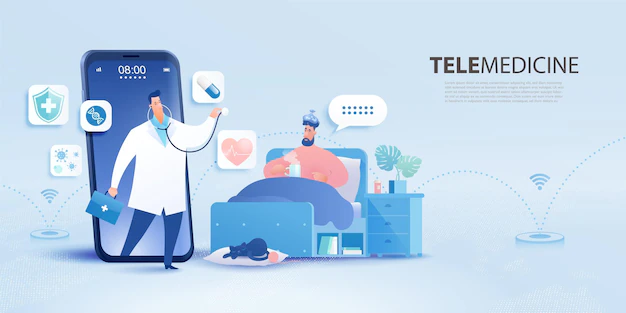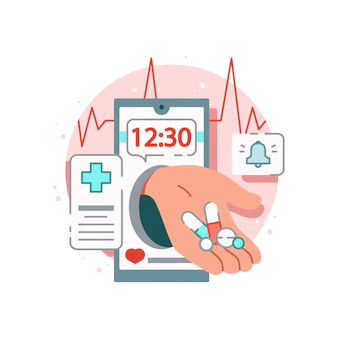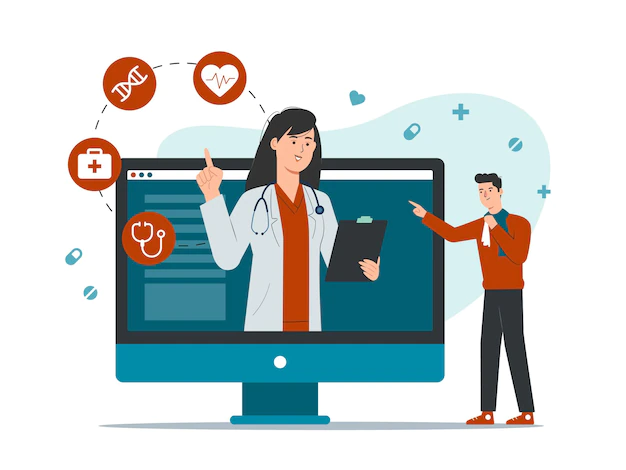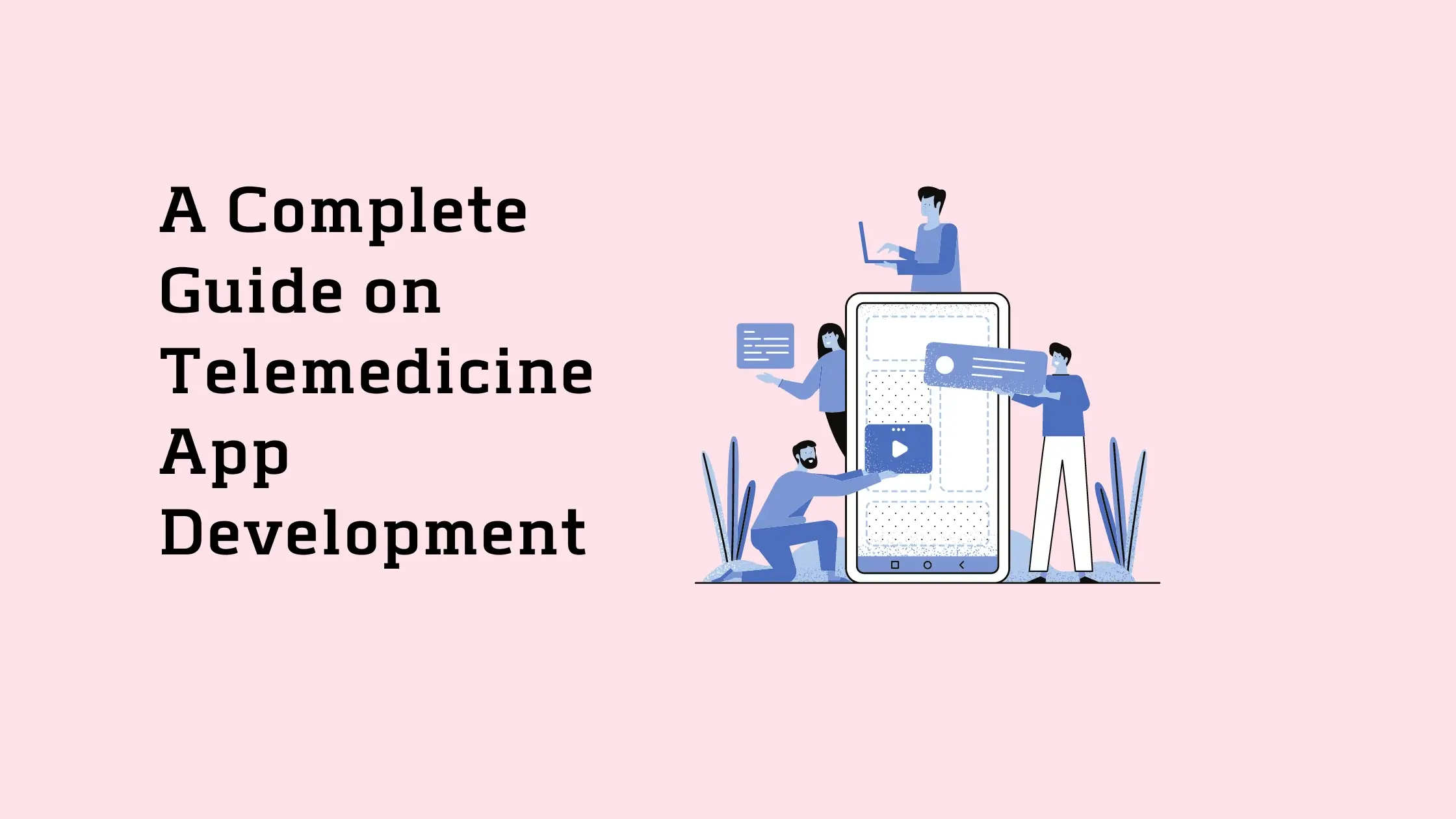Telemedicine refers to using information technology to make it easier to communicate in healthcare systems through interconnected means to ensure that remote patients can access medical services.

Telehealth apps are the main source of revenue for medical businesses that require specific software for Telemedicine to keep their medical level and management in the most current state.
One of the accelerators for kickstarting telemedicine applications is the enormous possibility of the worldwide health market.
Telemedicine Service in Numbers
Recent job postings show the huge demand for specialists in Telemedicine, specifically those in the Departments of Radiology and Psychiatry. Neurology, Family Medicine, Dermatology, Pediatrics, and Allergy and Immunology.
Telehealth techniques are so widespread that hospitals either invest in their implementation within their facilities for inpatients or are planning to do so within approximately 18 months.
The rise of mobile telemedicine applications, the latest trendsetters to create new communication methods between doctors and patients, is a sign of a steady increase
The extensive functionality efficiently integrated into a simple mobile interface design that provides the most pleasant user experience has allowed applications such as Doctor On Demand, LiveHealth, MDLive, Lemonaid, and HealthTap to hold leading positions in the field of telehealth.
Telemedicine Benefits
- Its increasing popularity can prove the advantages of Telemedicine with both patients and doctors.
- In general, as well as creating new revenue streams with Squash Apps that are more efficient for business, telemedicine applications can improve healthcare and assist in reaching many important objectives.
- Utilizing telemedicine applications for rural locations, patients living in rural areas could enjoy the best patient care at a lesser cost.
- Other groups of patients who benefit from the telemedicine solution are those who live in homes and those with a chronic illness who find it difficult to get into inpatient facilities on a regular schedule.
- Telemedicine’s importance cannot be overstated because it significantly decreased the time and costs patients otherwise need to pay to travel to healthcare facilities and wait in lines.
- Regarding the financial advantages of telehealth applications, it must be noted that telemedicine applications improve service delivery, making it cost-effective for patients.
- Through telemedicine applications, the service that would take a lot of time is now accessible on any device in other situations. In general, this can be extremely beneficial for diagnosing and monitoring remotely.
- The final reason to make use of Telemedicine is to receive an alternative medical opinion consulting online.
It is a relatively new phenomenon in the field of Telemedicine; the software development market is growing and changing from the store and forward’ model, which includes storing, collecting, and transferring the information to specialists, to the ‘tracking in the real-time model, which involves the continuous use of medically-focused components that are connected to mobile devices. Advantages of telemedicine solutions Taking account the facts mentioned that are presented, it is not a surprise that telemedicine apps development is a priority in a lot of businesses’ growth plans because it integrates into the digital world of healthcare and displays an excellent potential for engaging various categories of clients:
- Patients, particularly those who live in rural regions
- Doctors who need to keep the ill-management of their time
- Health system providers have the chance to automatize the administrative process and, in turn, improve the patient’s intake and enhance the quality of their health care experience.
Telemedicine apps use cases.
Telemedicine is responsive when integrating into different health care contexts.
In particular, it was a common scenario for the following steps:
- Remote visits and follow-ups via remote (for responding to patients’ questions and assessing their condition for cases in which there isn’t a requirement for readmission in the hospital).
- Discussion of test results (updating the patient with feedback regarding testing results).
- Video conferencing provides live consultation in real-time to different categories of patients, thereby improving accuracy in treatment.
- Learn how CodeIT has created a successful Telemedicine platform for children.
- Cloud-Based Consultations (for instance, treatment of burn injuries via the smartphone app).
- Online appointments are available to give medication guidance (drug interaction and medication adjustment requirements).
- Refills and prescription renewals upon request.
- Consultancy service to obtain an additional opinion on the diagnosis.
- Hospital operations are conducted remotely.
The telemedicine applications are diverse, from covering administrative functions aimed at improving the operations of healthcare facilities to meeting the particular requirements of a particular patient.
Do you need to develop an app for Telemedicine?
Telemedicine Application Features
Telemedicine apps generally come with three components: doctor app, patient app, and an admin panel.
All in all, services that allow communication between a physician and a patient differ greatly and could include meeting streamlining, 24-hour access to accredited specialists, and consultation on various health-related concerns, etc.
To understand the basic capabilities of these applications, let’s take a deeper look at the options available to Telemedicine software that cater to specific needs of users. These are the basic characteristics you’ll discover in any telemedicine application case study.
The features of the telemedicine app for patients
Here are the features of telemedicine applications for patients, which typically include:
- Registration
- Identity authentication
- Browsing doctors
- Examining the credentials of doctors
- When choosing an appropriate doctor
- Scheduling appointments
- Video/Audio online consultation
- Access to Profile and History
- Payment (as the majority of the cost of Telemedicine is usually covered by insurance, the possibility of incorporating the insurance provider’s details can be useful)
- Other features available in the app for Telemedicine can provide to patients include:
- Reviews to help you make the best selection
- Chat in-app (with or without support for webcams)
- The mobile application for Telemedicine should include Geolocation to provide the pertinent information.
- Cloud storage is used to keep records of visits and communication backup
Features of the app for telemedicine doctors
- Telemedicine apps for doctors are branded by features that permit:
- Authentication
- Making profile
- Scheduling/Rescheduling appointments
- Video/Audio online consultation
- Sharing prescription
- Feedback is needed
- Answering queries
- The charging and collection of payment are based on the remote visit’s visit’s completion.
Other useful features of telemedicine apps for doctors include:
- The database of medical prescriptions is expanding (to add descriptions in detail)
- Analytics dashboard
- Video session recording
Do you want to discuss your list of features?
The Admin Panel of the templates for telemedicine apps is designed with features that permit:
- Doctor Management
- Patient management
- Analytics and Reporting to forecast and modify the digital strategies
- Appointment management allows for workflow flexibility which reduces the workload of doctors and increases patient satisfaction
- Notification management to ensure that you receive the most up-to-date information.
- Integration with software for electronic health records (EHR) to ensure seamless scheduling
Challenges in Telemedicine App Development

Freepik
According to a telehealth history study: “…what brought the pace of development and new ideas in the area was NASA’s support of telemedicine initiatives throughout the 1960s and into the 1970s. In the 1960s and 1970s, as NASA was trying to resolve the complicated issue of providing health care to space-based astronauts as well as various telemedicine initiatives across the country and around the globe”.
This aspect implies that the history of apps that provide Telemedicine goes from the 1960s. It is possible that the advantages of app use far outweigh the minor issues that developers may have to face. The concept of telehealth is well-liked by both doctors and patients.
Yet, despite the rich experience and the health executives’ enthusiasm to integrate applications for Telemedicine into medical establishments, it will not eliminate all the challenges associated with implementation since the majority of issues in the development of apps for Telemedicine are a result of technical issues which can be solved by selecting a trustworthy custom software development company.
Challenge #1: UI/UX consider Squash Apps
Making the revolutionary software for Telemedicine requires a comprehensive solution for various platforms because one of the components will focus on the patients’ requirements. In contrast, the other part will focus on the doctor area.
The reason it’s so important is that the integration of two sets of functions that will evolve naturally is an important aim when designing the app’s interface.
Challenge #2: Backend Infrastructure
Another issue when creating the telemedicine app is backend integration, which would allow the exchange of data between doctors and patients app components.
Why is it important: Integrating two complicated systems is vital since it allows you to communicate or receive information in a flash.
Challenge #3: Compliance
The HIPAA (Health Insurance Portability and Accountability Act) Privacy Rule sets standards of protection for individuals’ medical records within health care systems, which includes the field of Telemedicine. This aspect makes conformity to HIPAA security rules a matter that is of paramount importance to app developers. This factor is among the biggest challenges in creating the top telemedicine apps for 2021.
It is crucial to keep this in mind: the exchange of data between applications, due to the risk of security breaches and the sensitive nature of the transferred data, the most secure protocols for data exchange, and strict compliance with all HIPAA standards should be used.
Challenge #4: Reimbursement
Utilizing telemedicine software as with Squash Apps can result in switching on the many legal issues. The majority of users are reimbursed for their telehealth visits. However, the coverage varies based on the rules and regulations in the state.
The reason so important: Legislative initiatives are being developed, so doctors and patients can engage in virtual meetings. Still, they should be mindful of the intricate legal framework that governs the application’s use.
What is the cost of a telemedicine application?
The use of Telemedicine in the outbreak COVID-19

Freepik
- Telemedicine was initially developed to connect medical professionals and those who live away from health centers or in rural areas and remote monitoring of those who suffer from chronic illnesses. In the wake of the introduction of the Covid-19 epidemic to our daily lives, the significance of Telemedicine has grown. In situations where many people are sick and require diagnostic treatment and hospitals are overcrowded, personal offline interactions must be avoided. Telemedicine applications have seen a significant surge in patients.
- It is worth noting that the foundations of the application of Telemedicine in the event of a pandemic have been established and tested before. In 2003, during the SARS epidemic, and again in 2013, the MERS-CoV outbreak was afoot. Thus, following the declaration of the Covid-19 pandemic in March 2020, medical specialists who had previous experience in these solutions managed the load and continued to offer services for regular non-Covid visitors and patients newly diagnosed suffering from infections.
- Likely the telemedicine sector has seen a huge increase in funds, and, according to certain reports, the total market’s growth surpassed the predictions of Covid of MAny fold. Since the beginning of fall 2021, humans are slowly starting to get used to the pandemic. In the words of Pfizer, the CEO of Pfizer, it should be possible to stop the illness completely by 2022’s close, including the consistent vaccination of all parts of society.
- This aspect has certainly reduced the growth of the market for telemedicine apps and development. But, a decrease in the inflow of capital isn’t expected as telemedicine applications have demonstrated their value and utility during the outbreak and remote care is a trend that is expected to continue in the next few years.
You can also consider the following in choosing the best telemedicine app such as Mobile Payments , Appointment Scheduling, Audio Conferencing, Chronic Disease Management, Hiring Process, Technical Solutions and Consultation Process
Consider us to develop your App Chat, IoT Telemedicine App Development, Healthcare Enterprise and Doctor On Demand App.
Concluding Thought
The delivery of health care via telehealth apps is increasing because of many reasons that favor embracing technology to create new opportunities. Patients of telemedicine apps appreciate it, and telemedicine statistics prove that.
Apart from the advantages that doctors and health professionals can reap from telemedicine apps, telehealth is the best option for patients since it makes it easy to schedule appointments, offers frequent consultations, seeing doctors from the comfort of your home, and reduces significant sums of money and time in waiting and transport and making telemedicine app advancement a promising area on the market of healthcare software.
FAQS
What is a telemedicine application?
Telemedicine applications allow patients to connect with doctors who offer consultation via video chat. Telemedicine uses information technology solutions to improve communication within healthcare systems through interactive methods to ensure that patients who live far away have immediate access to medical treatment services.
What features should be offered in a telemedicine application?
Telemedicine apps come with the components of the Doctor app, Patient app, and an admin panel. The capabilities of the patient app include searching for and selecting an appointment with a doctor, scheduling appointments and video/audio online consultations payments, etc.
How can you develop a telemedicine application?
Creating a telemedicine system involves the research, analysis, and design, including the features list, deciding on the technology stack, and the creation stage that follows with checking and maintenance. Please select the best telemedicine application development firm as it’s the most important factor in the success of your project.

Dr.Supreena has published two international books in finance with the able guidance of her guide and department at Ethiraj College of Women, University of Madras during her PhD in Economics and Finance. She is the Recipient of Dr Vedagiri Shanmugasundaram (An Oxford Scholar) Award for Outstanding and Successful PhD Candidate from Ethiraj College for Women concerning research record and academic distinction. She is experienced in the domain of finance, digital marketing and information technology writing on Artificial Intelligence, IoT, PaaS and SaaS cloud computing etc. She is NIIT qualified in Advanced Network Computing, Google Certified in digital marketing. Her hobbies to maintain balance and reduce stress are gardening and cooking.


